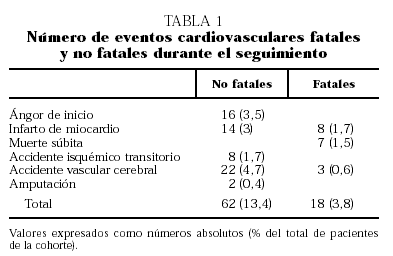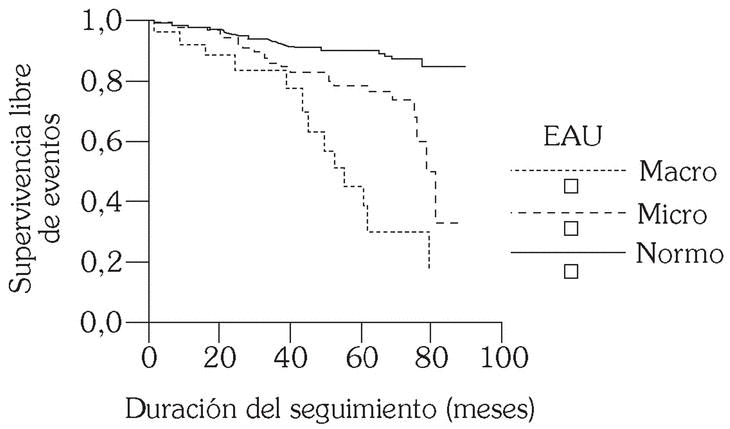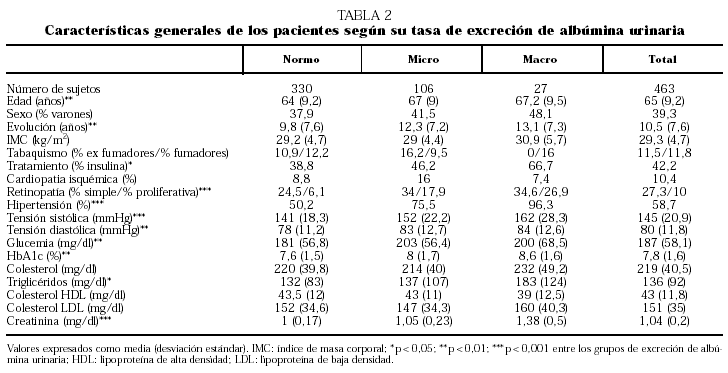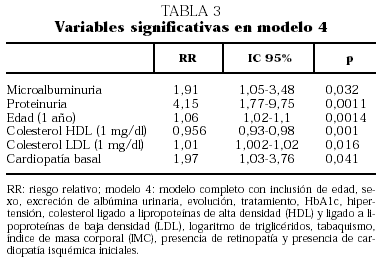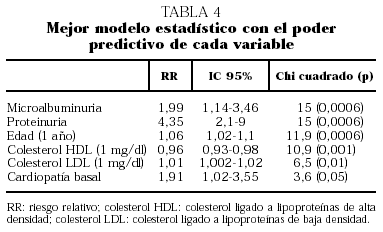Fundamento. El objetivo principal fue evaluar la contribución independiente de la microalbuminuria y de la proteinuria clínica a la morbimortalidad cardiovascular de pacientes con diabetes tipo 2. Métodos. Estudio de cohortes prospectivo con selección de pacientes con diabetes tipo 2 atendidos en consultas externas hospitalarias. Mediante modelo de riesgos proporcionales de Cox se analizó la importancia predictiva de la presencia de microalbuminuria y de proteinuria clínica sobre la aparición de eventos cardiovasculares fatales y no fatales (ángor de inicio, infarto de miocardio fatal y no fatal, muerte súbita, accidente isquémico transitorio, accidente cerebrovascular fatal y no fatal o amputación de extremidades inferiores). Resultados. Se siguieron 463 pacientes durante una duración media de 4,64 años (desviación estándar [DE]: 1,56). Hubo 330 (71,3%) con normoalbuminuria, 106 (22,9%) con microalbuminuria y 27 (5,8%) con proteinuria. La tasa de morbimortalidad cardiovascular global fue del 3,7% anual (2,46% anual para los normoalbuminúricos, 5,6% para los microalbuminúricos y 14,42% para los proteinúricos; p < 0,0001). Tras ajuste múltiple, tanto la microalbuminuria (RR: 1,91; IC 95%: 1,05-3,48; p = 0,032) como la proteinuria (riesgo relativo [RR]: 4,15; IC 95%: 1,77-9,75; p = 0,0011) fueron los principales predictores independientes de aparición de eventos cardiovasculares. Otras variables predictivas fueron la edad (RR: 1,06; IC 95%: 1,02-1,10; p = 0,0014), el colesterol ligado a lipoproteínas de alta densidad (HDL) (RR: 0,96; IC 95%: 0,93-0,98; p = 0,001), el colesterol ligado a lipoproteínas de baja densidad (LDL) (RR: 1,01; IC 95%: 1,002-1,02; p = 0,016) y la presencia inicial de cardiopatía isquémica (RR: 1,97; IC 95%: 1,03-3,76; p = 0,041). Conclusiones. El incremento de la tasa de excreción de albúmina urinaria es el principal predictor independiente de morbimortalidad cardiovascular en pacientes con diabetes tipo 2.
Palabras clave:
morbilidad, mortalidad, cardiovascular, microalbuminuria, diabetes tipo 2, proteinuria
Contex. The principal objective was that of evaluating the independent contribution of microalbuminuria and clinical proteinuria to the cardiovascular morbidity and mortality in patients with type 2 diabetes. Methods. A prospective cohort study with selection of patients with type 2 diabetes evaluated in hospital outpatient consultations. Through the Cox proportional risks model the predictive importance of the presence of microalbuminuria and clinical proteinuria on the appearance of fatal and non-fatal cardiovascular complications (angina, fatal and non-fatal myocardial infarction, sudden death, transitory ischemic attack, fatal and non-fatal stroke, or amputation of lower limbs) was analyzed. Results. The monitoring of 463 patients was done during an average period of 4.64 years (SD: 1.56). There were 330 patients (71.3%) with normoalbuminuria, 106 (22.9%) with microalbuminuria and 27 (5.8%) with proteinuria. The global cardiovascular morbidity and mortality rate was 3.7% annual (2.46% annual for the patients with normoalbuminuria, 5.6% for the patients with microalbuminuria and 14.42% for the patients with proteinuria; p < 0.0001). After multiple adjustment, both microalbuminuria (RR: 1.91; 95% CI: 1.05-3.48; p = 0.032) and proteinuria (RR: 4.15; 95% CI: 1.77-9.75; p = 0.0011) were the main independent predictive factores of appearance of cardiovascular complications. Other predictive variables were age (RR: 1.06; 95% CI: 1.02-1.10; p = 0.0014), HDL cholesterol (RR = 0.96; 95% CI: 0.93-0.98; p = 0.001), LDL cholesterol (RR: 1.01; 95% CI: 1.002-1.02; p = 0.016) and initial presence of ischemic cardiopathy (RR: 1.97; 95% CI: 1.03-3.76; p = 0.041). Conclusions. The increase in the rate of excretion of urinary albumin is the main independent predictive factor of cardiovascular morbidity and mortality in patiens with type 2 diabetes.
Keywords:
morbidity, mortality, cardiovascular, microalbuminuria, type 2 diabetes, proteinuria





